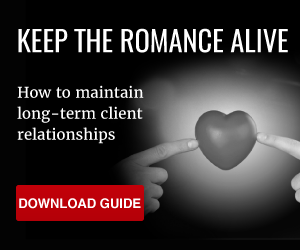
‘I knew we’d lost the client when he offered me a chocolate as we left the room.’
Rarely will a client actively avoid you before you lose them; more often than not there are subtler signs that your client isn’t happy. You need to recognise these clues and learn how to respond to keep your client engaged – and to know when a chocolate in the hand is a knife in the back.
Top five danger signs a client isn’t engaging with you
- Crocodile smiles. Don’t let the client’s politeness fool you. Overt politeness is often a cover for a lack of frankness in your interactions, meaning that your meetings become superficial and there’s no follow-up on your conversations.
- Proxies. If your client suddenly wants everything ‘approved’ by someone else in the business, or you’re unexpectedly palmed off to a colleague, it’s a sure sign you’re in trouble.
- Inconsistent communication. While it’s less common, delayed or no responses to emails and phone calls is a sure sign your client has become disengaged. Similarly, if they postpone meetings or replace the regular rhythm of monthly meetings with haphazard quarterly calls – you need to take note.
- Remoteness. The relationship suddenly becomes ad-hoc, distant and disorganised. There’s an absence of disclosure on the part of the client, and they don’t want to make long-term plans or discuss new opportunities. Perhaps they used to readily follow your advice and take suggestions and now they want to consult a third party before proceeding.
- Impossible to please. Mutual constructive criticism is a healthy part of any client relationship, but alarm bells should sound if it gets too one-sided. Your client makes vague unhelpful criticisms, becomes more offhand in their approach to your work and often niggles over the price and value of your work – nothing is good enough.
How to re-engage wandering clients
If you notice the signs a client isn’t engaging with you then there’s no need to despair. There are plenty of things you can do to get them back on board.
Diagnose and eliminate the obvious
First, if you can identify what’s causing the disconnection yourself – then do so.
- Is it a problem with rapport? Are you struggling to build a personal connection?
- Is it redirected frustration caused by someone or something else? Is there a barrier you are not aware of?
- Are you talking to the wrong person?
- Or is the client simply angered by a mistake or a delay in the work you’re doing for them?
The last is the easiest to deal with: take responsibility for the mistake and work with your client to rectify it.
If it’s the first, it might be a simple case of handing over the client to a colleague with whom they might have a better rapport. You cannot overlook this personal aspect; each party needs an emotional stake in the other’s success for a business relationship to work.
As to the second, the client probably just needs to vent. Ask them how they are, listen, but don’t probe, and then steer them back to the task at hand.
And as for the third, you might be engaging brilliantly with your client contact, but you’re getting nowhere because you’re talking to the wrong person. Know who the decision makers and influencers are in the business and be sure you’re engaging with them.
Deal with it head on
If you can’t self-diagnose and quickly remedy the problem, raise the issue with the client at your next meeting and find a way through it. Don’t be afraid to ask directly, ‘are we engaging with you in the way you want?’
You could even go so far as to ask a third-party colleague, typically a very senior colleague, to do a relationship meeting. This shows you’re taking the problem seriously and that the relationship is important to you and your firm.
Remember you’re not just providing a service, you’re a part of your client’s ecosystem – ask yourself if you are demonstrating value. Learn their pain points and focus on what matters to them.
Work to understand their needs and then offer them creative solutions – something they haven’t heard ten times before. And then explain how you can deliver on those ideas. Keeping on top of your client’s expectations is essential if you want to avoid losing them.
Crucially, you need to ask yourself if you are truly differentiating yourself from your competitors. It’s easy enough to spot a lack of differentiation when you’ve lost tonnes of business. And it becomes glaringly obvious when you’re fired. But a disengaged client could be exactly the warning sign you need to avoid those outcomes. So be attuned, remain self-aware and always question if you’re doing enough.
Will that be all?
A disengaged client doesn’t have to be a dead loss. If you feel your relationship has taken a knock, then put the effort in and show them you care.
Client relationships are not tick-box exercises; work to go above and beyond and tackle problems that they may not have even realised they have yet. Ask them: ‘Aside from the main project, what three other things do you want to achieve?’ They may be simple goals, but they might mean the world to your client.

Photo credit: Lady Dreadlock – “Disconnected”